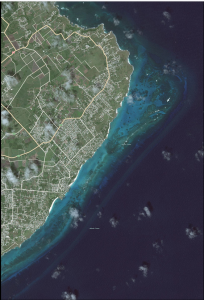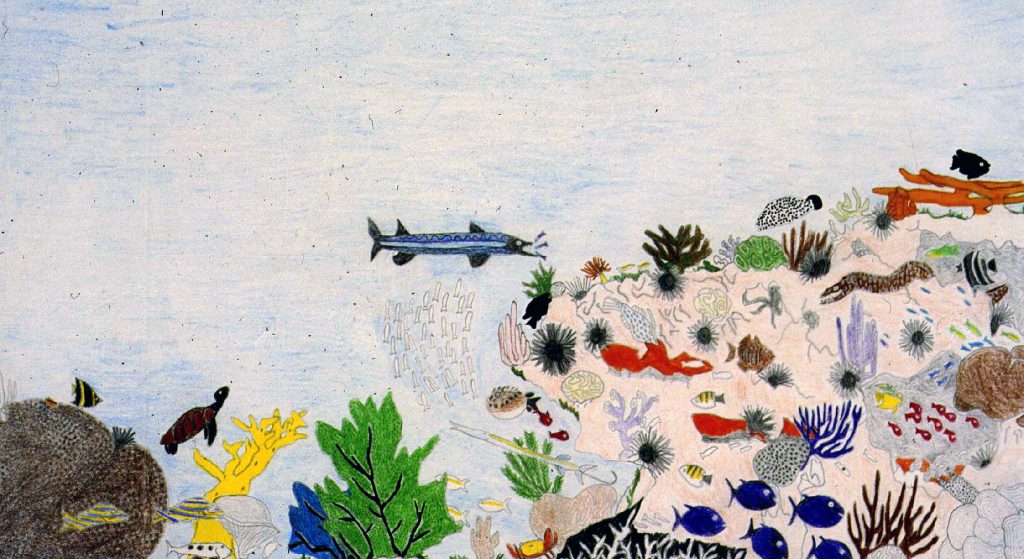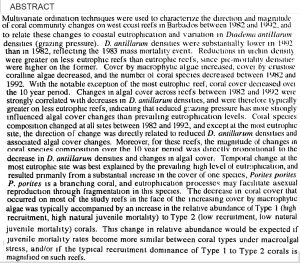Barbados : a coral paradise
Authors:Angelique Brathwaite, Hazel Oxenford, Ramon Roach Publisher: Miller Publishing Co. Ltd., Barbados, 2008; 96 pages : color illustrations. “This book showcases the beauty of Barbados’ coral reefs with text by the talented trio of marine scientists – Angie, Hazel & Ramon complemented by a collection of stunning and vivid photos.” Comment: This book is a treasure, possibly hard to come by now.

Satellite View of the northern part of Cobblers Reef by NASA. Link
Diving Cobbler Reef, Barbados
Post on wikivoyage First version posted Jan 16, 20i3. Lengthy description, maps, many photos. “Cobblers Reef is very apparent along the whole 16 km of the south east coast of Barbados, and local divers and fishermen dive and fish it a great deal, but they generally publish very little. Standard diving publications regarding Barbados hardly ever mention it, in spite of its visual prominence. This guide was prepared on the basis of 17 years of study and diving with local divers in an aim to fill in as many of the gaps in published knowledge as possible. It is ongoing.” (Accessed Jan 2, 2025). Also view on wikivoyage: Diving in Barbados
Reefs of Barbados
YouTube Video by Pawlik Lab “A video tour of reefs off the SW coast of Barbados, January 2019, at 10-25 m depth (see map at start of video).
Things to notice: (1) Huge biomass of large giant barrel sponges (Xestospongia muta) in unusual growth forms, with sponges overgrowing and smothering live coral heads, (2) fairly high coral cover, particularly of Madracis mirabilis in large mounds, (3) Acropora almost absent (only one patch seen), (4) low macroalgal cover, with lots of black spined sea urchins hiding, but cyano mats in some areas, (5) low fish abundance.
Lots of juvenile hawksbill turtles foraging for sponges – conservation programs are working!!
The coral reefs and coral communities of Barbados, W.I.
John B. Lewis. Can. J. Zwl. Vol. 38 (1960). A Classic. Unfortunately, the full paper is not publicly available (it can be obtained via university libraries). View Zones (this website) to read extracts from Lewis (1960) and view recent photos illustrating Lewis’s zones on Vauxhall Reef today.
CORAL REEFS AND THEIR MANAGEMENT (PDF)
Barbados Coastal Zone Management Unit, N.D. 4 page overview. Good description of spur and groove system of fringing reefs

Map of coral reefs around Barbados in Quantitative observations of a major coral bleaching event in Barbados, Southeastern Caribbean, Oxenford et al., 2007
Google Scholar: Articles by Hazel Oxenford
H.O. is Professor of fisheries and marine ecology at UWI, Cave Hill, Barbados. I think most would regard her as the leading researcher on coral reefs in Barbados today, inheriting that mantle from John. B. Lewis. Many research papers and other articles related to coral reefs in Barbados authored or co-authored by H.O. are cited with links to them on Google Scholar.
RESEARCH ON BARBADOS REEFS 1960-PRESENT (Some Highlights) Drafting, Many items to be added
1960:
The coral reefs and coral communities of Barbados, W.I.
John B. Lewis. Can. J. Zwl. Vol. 38 (1960). A Classic. The full paper is unfortunately still not publically available (I guess we have to wait 100 years.)
1987
Effects of eutrophication on reef-building corals. III. Reproduction of the reef-building coral Porites porites.
Tomascik T & Sander F. Marine Biology 1987;94:77–94. ” The reproductive season of two P. porites populations sampled from two polluted reefs began one to two months earlier than that of a P. porites population sampled from a less polluted reef…the mode of reproduction may be influenced by environmental conditions.”
1993:
The demise of the coral fringing reefs of Barbados and of regions in the Great Barrier Reef lagoon.
Peter R. F. Bell and Tomas (Tom) Tomascikin June 1993 Conference: Proceedings of the Colloquium On Global Aspects of Coral Reefs: Health, Hazards and HistoryAt: University of Miami, Miami, USA. Abstract:The fringing reefs of Barbados are in a very poor state of development when compared with earlier descriptions. The historical data demonstrate a close correspondence between the demise of the coral reefs with increased tourism and industrial development and the resulting degradation in water quality and associated eutrophication. The studies indicate that chronic low level of eutrophication can restrict coral growth and reproduction and in doing so inhibit the recovery of damaged reefs…”
1994
Hunte W, Allard P. Temporal changes in coral reef communities on the west and south coasts of Barbados: 1982–1992. Bellairs Research Institute for the Coastal Conservation Project Unit of the Government of Barbados and the Inter-American Development Bank, Washington, DC, 1994. 61pp. ” Hunte and Allard [61] found that the abundance of P. porites on Barbados fringing reefs was higher at increased eutrophication levels. Branching corals such as P. porites rely on fragmentation as their principal mode of propagation. It is thought that fragmentation occurs more easily under eutrophic conditions…”
Changes in coral community structure in Barbados: effects of eutrophication and reduced grazing pressure.
Patrick Allard, MSc thesis, McGill University. 1994.
2002
Evidence from aerial photography of structural loss of coral reefs at Barbados, West Indies
Lewis, J. in Coral Reefs 21, 49–56 (2002). “In response to concerns about widespread degradation of coral reefs at Barbados, West Indies, over the past two decades, maps and planimetric areas of 20 fringing coral reefs were estimated from enlargements of aerial photographs of the island, using geographic information system analysis. There were statistically significant reductions in reef areas over a 40-year period from 1950 to 1991. Areal losses exceeding measurement and boundary interpretation errors of 10% were detected on eight of the 20 reefs. Ground validation carried out by divers on six of the reefs confirmed physical losses of reef structures and accumulation of rubble and sand substrata at sites where substantial planimetric area loss was detected on aerial photographs. Structural losses occurred along the “spur and groove” system of the reef-seaward edge, within deep channels or breaches in the reef front, and along the flanks or ends of reefs. The location and nature of the observed losses suggest that storm damage and seasonal alterations in beach morphology are the two most important factors contributing to geomorphological structural loss of the reefs.”
2006
A standard unit for monitoring recruitment of fishes to coral rubble.
Vallès H, Kramer DL, Hunte W (2006) in Journal of Exoerimental Marine biology and Ecology 336:171–183 “We developed a benthic standard monitoring unit for recruitment of fishes (SMURF) to sample fishes that settle in coral rubble and tested it on three fringing reefs on the west coast of Barbados, West Indies. These rubble SMURFs are inexpensive to construct and permit newly settled fishes, including cryptic, secretive and small species, to be quickly and fairly completely (> 83%) removed by divers without returning the unit to the surface… The studies were carried out on fringing reefs, in the zone described by Lewis (1960) as the “reef front”. This zone is approximately 250 to 300 m offshore, at a depth of 7 to 12 m. The habitat is a dense, patchy mixture of live coral heads, sponges, sand and rubble, with similar or higher reef-fish density and diversity than shallower zones of the same reefs.” (Reserach based at Bellairs Research Institute in Holetown, Barbados).
2007
Impacts of landuse and runoff water quality on coral reef environments in Barbados
Marko Tosic 2007 Thesis for: Master of Science, McGill University. The effects of terrestrial runoff on the Bellairs fringing reef environment were assessed by a study of water quality. A lot of detail, evidently not published separately.
The destruction of a large Acropora palmata bank- barrier reef and subsequent depletion of this reef-building coral off Barbados, WI
MacIntyre et al., 2007.In Atoll research Bulletin. “Nine study sites of the reef crest along the entire length of a 15 km-long bank-barrier reef off the southeast coast of Barbados indicated that the surface is composed of mostly reworked fragments of Acropora palmata covered with macroalgae, crustose coralline algae and turf algae. Known as Cobbler’s Reef, this feature had no live colonies of A. palmata at our study sites and supported only small scattered colonies of corals, mainly Diploria spp., Porites astreoides and the hydrocoral Millepora complanata. Eleven of 29 surface-sample radiocarbon dates plot above the western Atlantic sea-level curve between approximately 3,300 to 4,500 cal yrs (calibrated, calendar 14C years) ago. This suggests that the reef complex was extensively damaged by a series of severe storms during this period… Finally, the turbidity associated with the clearing of land for sugarcane agriculture in the mid-1600s likely killed the last of the sediment-sensitive A. palmata on Cobbler’s Reef. The more recent almost complete loss of A. palmata from other reefs off Barbados is probably related to storm damage and nutrient runoff and construction associated with tourism development.”
2016:
Mapping the return of acroporid corals on fringing reefs along the west coast of Barbados
R. MACLEAN AND H.A. OXENFORD, 2016. Centre for Resource Management and Environmental Studies (CERMES), The University of the West Indies,
Cave Hill Campus, Barbados
2022:
Spotting hopeful signs for coral health in Barbados’s backyard
By Linda Nordling for Nature, WHERE I WORK. “In his diving surveys, ecologist Henri Vallès is finding that some coral populations might be on the mend.”
2023:
A metagenomic-based study of two sites from the Barbadian reef system
S. Simpson et al., 2023. In Coral Reefs “We study the microbiome of sea water collected from two locations of the Barbadian coral reefs. The two sites differ in several environmental and ecological variables including their endogenous benthic community and their proximity to urban development and runoffs from inland watersheds…Although both sites exhibit a similar degree of richness, the less urbanized site (Maycocks reef at Hangman’s Bay) has a strong concentration of phototrophs whereas the more urbanized location (Bellairs reef at Folkstone) is enriched for copiotrophs, macroalgal symbionts and marine-related disease-bearing organisms from taxa scattered across the tree of life. Our results are concordant with previous profiles of warm ocean surface waters, suggesting our approach captures the state of each coral reef site, setting the stage for longitudinal studies of marine microbiome dynamics in Barbados.”
2024:
Assisted recovery of elkhorn coral (Acropora palmata)on a fringing reef in Barbados: A pilot study 2016-2019, 2020 Final Report
HA Oxenford et al., 2024 CERMES Technical Report No 109, 56 pages
Toward a Multi-stressor Theory for Coral Reefs in a Changing World
Carling Bieg, Henri Vallès, Alexander Tewfik, Brian E. Lapointe & Kevin S. McCann. 2024. In Ecosystems Manuscript PDF available here
“Coral reefs are facing a constant barrage of human impacts, including eutrophication, overharvesting and climate change. While the local effects of overharvesting have been well-studied, regional nutrient loading from anthropogenic activities on land and global climate change-induced disturbances are increasing in magnitude and necessitating cross-scale multi-stressor approaches for coral reef ecology. Here, we expand on longstanding theory to develop an integrated multi-stressor framework for coral reefs. We show that: (i) The geometry of a simple, empirically motivated model suggests nutrients and harvesting can operate similarly, and synergistically, in driving shifts from coral- to algae-dominated reefs, resulting in clear context-dependent management implications; and (ii) this same geometry suggests climate-driven coral mortality can drive the presence of long transients and climate-driven alternate states, even in moderately impacted ecosystems. Reefs seemingly in a “safe space” based on individual stressors may in fact be much more susceptible to increasingly frequent storms and bleaching events in multi-stressor conditions. By integrating these findings with general ecological and theoretical concepts, we suggest that responses in benthic composition may act as “signatures of change” to multi-stressors, allowing us to develop a predictive and generalizable multi-stressor framework for coral reefs under global change. In line with this theory, we detail empirical evidence from Barbados of historical changes in reef composition and multi-stressor impacts within our framework. By bridging coral reef ecology and general ecological concepts, we can better understand ecosystem functioning and resilience in these important yet highly threatened systems.” The paper reviews, makes extensive use of historical research on coral reefs in Barbados.
2025:
Tracking Over 30 Years of Coral Reef Infrastructure Degradation in Barbados
Aliyah Grffith et al. 2025. In Nature Scientific Reports
“Abstract
Coral reefs face escalating threats from global and local stressors, and these challenges are exacerbated in the Caribbean. This study focuses on coral reef structure in Barbados, where a previous study documented reef degradation in the 1990s. As 30 years have passed, we examined the rate of change of reef structure and quantified associated substrate presence along the western reefs of Barbados. Using satellite and geotagged imagery, we analyzed 19 reef structures over the interval 2013 to 2023 along the west coast of Barbados, comparing them to the previous study’s findings in 1950 and 1991. We ground-truthed five sites previously categorized as highly degraded reefs to confirm their structural integrity and substrate-type. Results confirmed ongoing reef structural loss, averaging ~ 137.68 m1 annually across all sites. We identified four primary substrate types: coral, algae-covered substrate, rubble, and sand, with algae-covered substrate predominating and projected to persist. Our results underscore the urgency of monitoring reef health and highlight the potential limitations of satellite assessment. This research enhances understanding of reef dynamics and offers a framework for identifying vulnerable areas, which are crucial for effective conservation efforts.”
…In response to concerns about the degradation of the reef ecosystem along the Barbados coastline, Lewis (2002) compared aerial photographs of 20 fringing coral reefs over a 40-year interval from 1950 to 1996. He found reef size impacted the loss percentage and overall area difference, but location relative to the island did not. Eight of twenty reef sites were categorized as locations experiencing “high degradation,” and sketches and descriptions were developed based on reef observations. Over thirty years have elapsed since the initial study found degradation at some sites…During that > 30-year interval, reefs along the Barbados coastline have been exposed to even more intense global and local stressors not previously considered, including carbonate budget shifts, macroalgal blooms, and disease..
No-take area status is not sufficient to protect the population of a reef-building coral in Barbados
Henri Vallès et al., 2025 in Marine Environmental Research. Highlights
• The massive starlet coral (Siderastrea siderea) is an important reef building coral
• In 1997, the no-take area of Barbados hosted a healthy population of this coral
• 2.5 decades later, this population has suffered a strong loss of large colonies
• The no-take status of its location was not enough to protect it from degradation
• The future of this coral population is seriously threatened
From Spaulding et al.2001: World Atlas of Coral Reefs
Barbados is, in many ways, an anomaly. It lies east of the main Lesser Antilles chain in the Atlantic Ocean. Fringing reefs are largely absent, although there is a small fringing structure near Folkestone on the leeward west coast. There are also sub-surface reefs along this coast, where a gently sloping shelf extends about 300 meters seaward to a depth of 10 meters. At the edge of the shelf, the sea floor drops evenly to a depth of about 20 meters. Seaward from this there are further submerged patch reef structures, together with two larger bank barrier reefs, 12-20 meters deep and up to 100 meters wide. Offshore, submerged bank barriers are also found off the southeast coast. The eastern, Atlantic, coast is subject to very high wave energies throughout the year, and much of this coastline is a bare carbonate platform extending out to deep water. Nearshore reefs in Barbados have suffered considerably. Reef flat corals disappeared over 100 years ago with the intensification of agriculture, while considerable declines in coral cover and diversity have been reported on offshore reefs since the 1980s, linked to eutrophication from urbanization and tourism developments.

A young boy’s depiction of the “Bellairs Reef” in 1978. My son, Graham, made this coloured-pencil drawing as a six year-old. We had spent a couple of months at the Bellairs Research Institute in the summer and he made the drawing after our return home in the fall, As I remember, he surprised us with it, it wasn’t prompted. We had Idaz Greenberg’s Guide to Coral and Fishes of Florida, the Bahamas and the Caribbean (1977) which he would have referred to. I think only the barracuda he might not have actually seen on the reef; the other fishes (e.g. glassy sweepers in crevices, blue tangs) and invertebrates (e.g. Diadema, gorgonians) were all common at the time, and he accurately depicts the abundance of coralline algae on the reef framework at right. Original is 34.5 x 19.2 cm.
Click on image for larger version
Publications of some Barbados-intensive researchers on Google Scholar:


